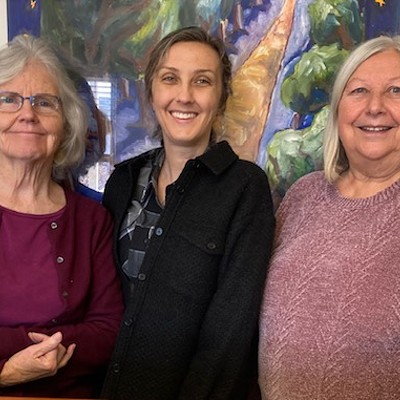Nakedness has played a potent role in human culture from ancient times to this very minute. Consider the flagrantly fertile Venus of Willendorf, the reclining-nude paintings of classical art or the latest Burton snowboard. Once upon a time, appearing in your birthday suit was, well, natural. But thanks to centuries of religious interference (nakedness = sexuality = sin), the human body went undercover. Repression gave rise to prurience, accompanied by an interesting psychological quirk: In our times, the suggestion of nudity provokes more than the full monty. There’s a reason “strip” and “tease” go together.
But along with its titillation, almost-nudity can be deliciously silly. How else to explain another modern artifact, the “naked calendar”? No, not those bosomy, airbrushed Vargas girls, once seen on calendars at filling stations across the land. We’re talking ordinary folks with ordinary bodies getting nekkid to raise money — and eyebrows.
In 1999, Merry Olde England produced the best-known and possibly first calendar of this ilk: The matrons of a Yorkshire women’s club disrobed to benefit cancer research after a member’s husband died. Their story was the basis for the 2003 movie Calendar Girls. But by that time, enterprising Vermonters had already followed suit with a wildly successful 2002 calendar featuring “The Men of Maple Corner,” which raised a whopping $500,000 to renovate the local community center. A sequel, in 2003, brought in another 100K. The benefits extended to the guys in the pictures, who encountered their own heady, if short-lived, fame. According to a 2002 article in the Times Argus, Mr. July was “attacked and kissed” by an unknown woman as he marched in a Montpelier parade.
Now the good citizens of Shoreham, Vermont, have thrown their, er, clothes in the ring. Shoreham Uncovered brings a little zing to 2009 with 12 full-color photographs featuring townspeople in familiar locales — and little else. What sets this calendar apart from its predecessors is the diversity of the participants: men and women, old folks and young, natives and newcomers are all in the buff together. Calendar sales will fund a much-needed addition to the Platt Memorial Library, a quaint but undersized 1906 brick structure.
Last Friday, 10 Shorehamites crammed into the 936-square-foot library with a Burlington journalist to share their stories — and a secret — about baring all for books.
******
For motorists heading south from Vergennes on Route 22A, Shoreham doesn’t even rate a mileage sign. (One eventually appears farther down the road, just past Bridport.) The two-lane highway ribbons through western Addison County, bisecting fertile fields and apple orchards and minuscule towns, all of them hugging the gentle slope toward Lake Champlain. The area affords sweeping views across the ancient bowl formed by the Green Mountains to the east and New York’s Adirondacks to the west. Agriculture still rules here, despite the decline of family dairy farms. The population of Shoreham, chartered in 1761, is currently 1276 — not including, as locals like to say, the cows and sheep.
New people have been settling in, though, bringing with them home-based businesses such as computer repair, digital photography and web design. Unlike many rural outposts in Vermont, Shoreham is wired — by its very own local telephone company.
On the day after Thanksgiving, “Black Friday” doesn’t seem to have gripped this town, unless people are shopping online. One group of residents evidently has nothing more pressing to do than gather at the diminutive library. The first to arrive is Phil Rivlin, 63, the mustachioed owner of Red Sled Christmas Tree Farm and the calendar’s “Mr. December.” In the photo, he poses with a chainsaw and a well-placed conifer à la Rusty DeWees. The two college-age boys cavorting like elves in the background are the sons of Todd and Lisa Balfour, the photographer and photostylist, respectively, of Shoreham Uncovered.
The Balfours are relative newbies in town; they moved here from Kansas City, Missouri, about eight years ago and established their eponymous photography studio. Like everyone else involved, they volunteered their time and talents for the calendar.
Today, the couple take their places on library folding chairs as others file in, greeting each other with the fond familiarity of good neighbors. The youngest person in this gathering is Shannon Bohler-Small, 40, president of the Friends of the Platt and an events and administrative coordinator at Middlebury College. The oldest is 70-year-old Friends member Pete Wimmer. A retiree from Midd, he still serves in an advisory capacity for the state’s endangered species committee and the Agency of Natural Resources. “I didn’t strip,” he confesses, evoking spirited ribbing from the others.
The group spends several minutes joshing good naturedly — the kind of inside jokes likely exchanged only by people who have posed for a naked calendar together. Someone confides that the experience did engender a teensy bit of lust — or at least envy. “I coveted her boobs,” says one woman of a fellow model. “I want her abs!” exclaims another.
On this end of the photo project, there’s a no-big-deal attitude about nudity. But getting people on board at the outset, nearly two years ago, took some finesse.
Leslie Goodrich, 50, is the woman everyone calls “the instigator” of the calendar, though she doesn’t appear in it. A speech pathologist in local public schools, she wasn’t sure it would be appropriate. And her husband, she notes with a meaningful look that needs no explanation, “works for the federal government.”
Goodrich recalls that the library committee was tossing around ideas for a really effective fundraiser that would “reach out beyond the community.” The Friends had already hosted local events such as wine-and-cheese soirées and plant sales, which brought them just a third of the way toward their goal of some half-million dollars. Once the naked calendar suggestion came up, “We had a lot of fun imagining people in different scenes,” Goodrich says with a wicked grin. “Then we contacted Todd.” Still, getting going was slow.
The Balfours started with one or two photos and “shopped them around,” Todd says. “It was a joint thing with Lisa and I: We’d call up the victims to ease them in . . . It took some talking.”
But then they found people who were “really into it,” including Noggin Orchard owner Sanford Witherell Jr. and his Jamaican apple pickers (September).
Word of mouth spread around town. “Then it became, people wanted to do it,” says Goodrich. ‘Did you do yours?’ she mimics.
“Jeremiah was insulted that we hadn’t asked him,” someone says, poking fun at Jeremiah Parker, 59, who smiles broadly while trying to deny the charge. Because of some no-shows at his photo shoot, the hale co-owner of Parker Restoration appears three times — thanks to digital magic — in the depiction of a barn-restoring gig (April).
For Jim Ortuno of Shoreham Upholstery, posing became a family affair in his business’ workroom (March). His daughter Chelsea plays faux mechanic, her bare legs and high-heeled feet emerging from under a cherry-red 1950 Ford convertible; his wife’s legs descend a staircase in the background. Ortuno’s burly manager Ethan McArdle strikes a muscle-man pose in the front seat of the car. (Both men reappear as firemen on the October page.)
The doctored license plate on the photo’s Ford reads “DOMINIC,” a reference to Dominic Francis, proprietor of the Shoreham Inn and a stripping-resistant friend of Ortuno’s. The two men “are always playing tricks on each other,” informs Goodrich. This trick must have helped: Eighteen individuals, from an infant to senior citizens, eventually posed in the inn’s pub, with Francis and his wife Molly — also the library treasurer — ensconced behind the bar. Though the tableau illustrates the first month of 2009, it was one of the last created.
It took the longest, too, says Todd Balfour. Scheduling for a crowd was a challenge, and “a lot of thought went into setting it up,” he recalls. “Lisa and I got there two hours ahead of time to decorate.” Another hour was spent placing people and props. “Actually shooting it took probably 20 minutes,” Balfour says.
And then came several hours of Photoshopping at Balfour Studios — the “secret” behind the naked calendar. Some models did bare all, surprising their neighbors with an utter lack of inhibition. But most actually wore shorts, bikinis or nude bras and panties, which Balfour carefully “erased” on his computer. In fact, Shoreham Uncovered is a digital masterpiece: Barring strategically placed props — the most inspired being a pair of water jugs a waitress holds over her breasts at the Shoreham Inn — these people really look naked. And for viewers, that’s all that matters. The implication of nudity, once again.
Even that was unnerving for some models. Though librarian Dianne Lawson is smiling — and discreetly obscured by a server’s round tray — in the Shoreham Inn photograph, she admits thinking, I’ll have to see these people afterward. “My husband says I’m the only one in the whole calendar who’s blushing,” she offers sheepishly.
“When we talked to people, we emphasized, ‘Whatever your comfort level is, we’ll work it into the shot,’” says Lisa Balfour.
Her husband picks up the thought: The photo taken at Golden Russet Farm — owned by Vermont State Rep. Will Stevens and his wife Judy — “represents a wide array of comfort levels,” says Todd. Way in the background and almost invisible, one modest woman peeks from behind a hay roll. Standing in front of a battalion of sunflowers, a hunky young man holds a bushel of corn with confidence. “He’s working on being a professional model,” someone explains. Farmer Will waves from his tractor; Judy appears to emerge from a large bin of apples. Nearly everyone is creatively obscured by produce, giving new meaning to the term “organic” — and illustrating the stylistic wit of the Balfours, who worked for Hallmark Cards before moving to Shoreham.
But this photograph is not just jokey; it’s lovely. Todd stood at a distance to compose the agrarian tableau, framing his human subjects with the early-morning mist rising from the field behind them, a tree line farther back, and a baby-blue sky with ethereal clouds overhead. The combination of sunflowers, golden light and the relative diminutiveness of the people makes this look, at first glance, like an Anne Geddes shot with grown-ups.
Has anyone in town been offended by the naked calendar project? “If so, they haven’t said anything,” says Lawson. “My pastor bought one.”
The ladies’ prayer circle at the Methodist Church reportedly bought multiples. “We’re in the aisles of the house of the Lord, and ‘I’ll take three,’” someone chortles.
“There’s a huge perception of the religious right, but in Vermont there’s an attitude of ‘live and let live,’” offers Bohler-Small. “Anywhere there’s a strong sense of community, that overrides the fear.”
******
Librarian Lawson was new to town when the calendar project began. But the relative brevity of her tenure in Shoreham is belied by her devotion to the library and encyclopedic grasp of its history.
That started when Dr. Mary Mixer Platt erected the structure in memory of her husband, Dr. William Platt. The physician couple served the town for 34 years. “We’re a welcoming library,” Lawson boasts. “We take all comers from surrounding towns.” The library, which issues borrower cards for free, operates on a modest $26,000 per year. (“We’re asking for $27,000 next year,” Lawson reveals, “but we’re not there yet.”) Moreover, the vintage charm of the Platt makes it a “tourist destination,” she continues, attracting visitors such as bicyclists who stop over at the Shoreham Inn, just across the street.
“We have more grown-ups than adults,” Lawson misstates, eliciting hoots of laughter. “That explains a lot,” someone quips.
“We have about two-thirds adults and one-third juvenile,” the librarian corrects herself. Seasonal laborers and second-home owners bulk up the borrowers’ list, too.
The Shorehamites clearly share Lawson’s pride in their little library. The only problem, everyone agrees, is that it’s too little.
“We started thinking about the building addition eight years ago,” says Judy Stevens, a member of the Friends committee. But the planned addition is not just about expanding the facility for its 978 cardholders and making it handicapped-accessible. It’s about providing another gathering place for the community. Shoreham’s residents, it appears, are determined to remain close knit.
“The common thread used to be, you shared a common lifestyle — farming,” Goodrich says. “Now we have very diversified lifestyles, but we still have common needs — the roads, the weather. And there’s not the same opportunity to understand all the lifestyles.”
“The town has changed — there’s so many new names,” says Karen Shackett, 46. A stewardship officer at Middlebury College, she grew up in Shoreham on a now-defunct dairy farm and traces her local roots back through her great-grandparents. One of them, she shares, used to “squire Dr. Platt around town on her rounds.” Now, Shackett estimates, “there’s a two-thirds turnover” in the population.
“That’s why community places are so important,” interjects Bohler-Small. “You can’t just meet them all at the recycling. We all like to see each other,” she adds fervently. “We need meeting places!”
“We have to take care of ourselves,” says Shackett. “We’re too far from anyone else.”
“That’s why so many people participated in the calendar,” Bohler-Small resumes. “Everyone appreciates the library.”
“It’s been fun to do this, because we’ve gotten to know each other better,” says Goodrich. “If you can get naked together, you can build a library together.”
Being unclothed is scary for a host of reasons — a sense of vulnerability perhaps most primal among them. But in facing down common individual fears, it seems, the people of Shoreham have discovered there’s uncommon strength in naked numbers.






Comments
Comments are closed.
From 2014-2020, Seven Days allowed readers to comment on all stories posted on our website. While we've appreciated the suggestions and insights, right now Seven Days is prioritizing our core mission — producing high-quality, responsible local journalism — over moderating online debates between readers.
To criticize, correct or praise our reporting, please send us a letter to the editor or send us a tip. We’ll check it out and report the results.
Online comments may return when we have better tech tools for managing them. Thanks for reading.